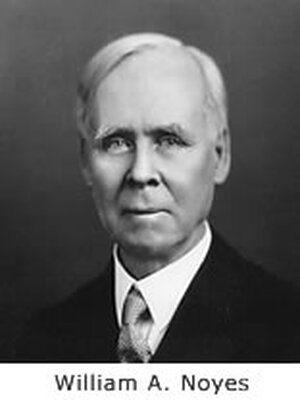
William Albert Noyes was born on November 6, 1857, on a farm near Independence, Iowa, the youngest son of Spencer W. Noyes and Mary Noyes. In 1875 he entered Grinnell College, where he enrolled in classical studies, reading chemistry on the side, teaching full-time in country schools during the winter quarters, and graduating with AB and BS degrees in 1879. He taught and studied analytical chemistry at Grinnell until January, 1881, when he entered Johns Hopkins to work under Ira Remsen. Although he performed water analyses to pay his expenses, he still received his PhD degree in one and a half years (1882). His dissertation, on the oxidation of benzene with chromic acid, also earned him an AM degree from Grinnell. After various teaching posts, in 1903 he became the first Chief Chemist at the US National Bureau of Standards in Baltimore, Maryland, where he determined atomic weights. His value for the crucial H/O weight ratio (1.00787:16) still stands today as one of the most precise chemical determinations ever made. He and H. C. P. Weber received the 1908 Nichols Medal for their determination of the atomic weight of chlorine. He became Head of the Chemistry Department (1907-1926) at the University of Illinois, which he built into one of the most prestigious departments in the United States.
Primarily an organic chemist, Noyes worked on the structure of camphor (first to furnish definitive proof of its structure) and rearrangements in the camphor series, the electronic theories of valence, and the valence and nature of nitrogen in nitrogen trichloride. He developed methods for the determination of phosphorus, sulfur, and manganese in iron. Long-time Editor-in-Chief of the Journal of the American Chemical Society (1902-1917), he was also the founder and first Editor of Chemical Abstracts (1907-1910), ACS Scientific Monographs (1919-1941), and Chemical Reviews (1924-1926). In 1935, he received the Priestley Medal.
After World War I Noyes worked unsuccessfully to establish harmony between his French and German colleagues and to promote international understanding. He died on October 24, 1941.